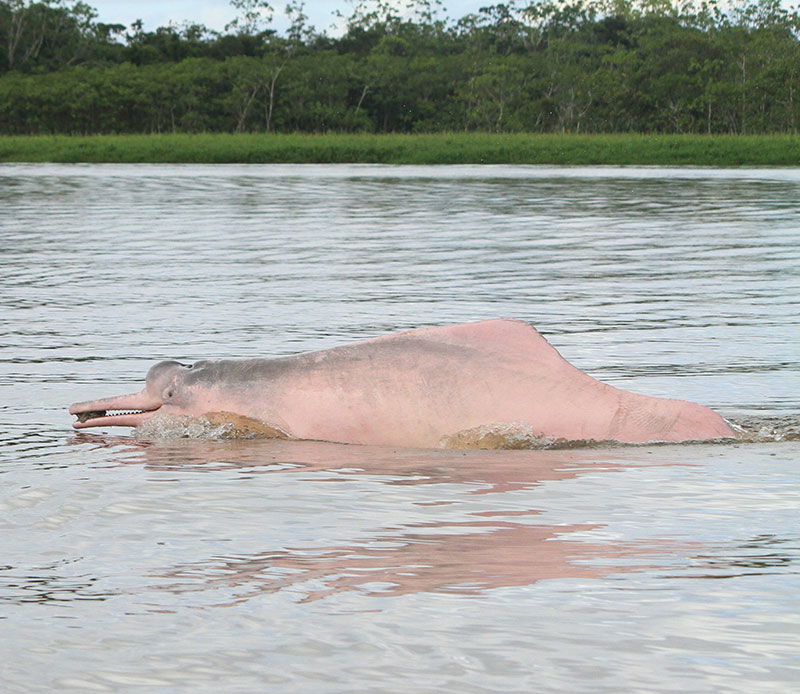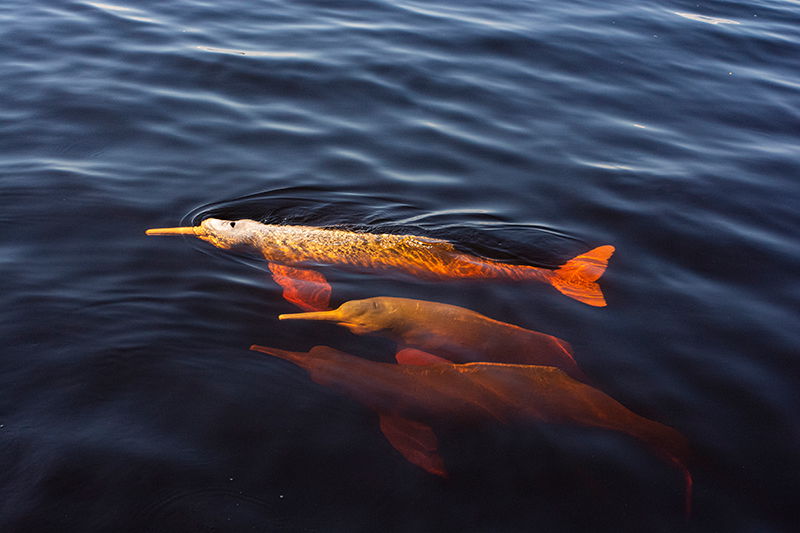Amazon River Dolphins—Unique in Pink
Mantra088, CC0, via Wikimedia Commons
How many animals can you think of that are pink? Flamingos. Pigs. Any others? Well, you’ll be tickled pink to learn that you can add another animal to that list—the Amazon river dolphin.
These dolphins aren’t born pink. They’re born gray and then change color as they get older. Scientists aren’t exactly sure why this happens. The dolphins might turn pink because of their diet. Many of the fish, crabs, and other things they eat contain a pink pigment. (Another example of this is the flamingo, which is pink because of its diet.)
Some scientists think that Amazon river dolphins—commonly called botos—might turn pink because of the scars they get over the years from fighting and playing rough with each other. The male dolphins are more aggressive than the females. As their injuries heal, their wounds are covered with pink scar tissue. The pink scars replace their gray skin. Older male dolphins are often more pink than females. The brighter pink a male dolphin is, the more attractive he is to the females. A boto’s pink coloring can range from light pink to rosy pink to bright flamingo pink.
The color of Amazon river dolphins isn’t the only feature that makes them unique among other dolphins. God created the original dolphin kind on day five of creation week. He programmed all the information the original animal kinds would need to adapt to new environments. Botos developed some special designs to survive in the rivers of South America.
There are a lot more obstacles in the Amazon River than in the open ocean—such as rocks, boats, trees, and plants. How does the boto navigate these crowded waters? Unlike other dolphins, the boto’s spine is not fused together. This means it has a super flexible neck, allowing it to twist and turn among rocks, trees, and other obstacles.
Although these dolphins have small eyes and bad eyesight, they have pupils that have adapted to dilate (get bigger). This helps their eyes take in more light so that they can see more clearly in their cloudy, dark waters. Botos have long, skinny snouts that are helpful for rooting through mud and darting among branches to catch prey. They have stiff hair that grows on their noses. Most dolphin species are born with hair on their bodies, but it falls off as they grow. The hair on the boto’s nose stays put—probably to help it feel things at the bottom of the river. (That’s like how a cat’s whiskers help it sense its surroundings in the dark.)
Inside those sharp snouts, botos have a mouthful of teeth—including big, molar-like teeth that no other species of dolphin has. These extra-strong teeth let them grind and chew food. Thanks to this design, botos have one of the most diverse diets of any dolphin. They can eat turtles, frogs, crabs, and over 50 different types of fish.
It wasn’t part of God’s original plan for animals to hunt and eat other animals. Originally, all animals, including the dolphin kind, only ate plants. But God knew that, in a fallen world affected by sin, dolphins would have to survive in different environments. He lovingly provided them with the features they would need, no matter where they lived—even the Amazon River.
Like other dolphin species, botos have an ability God gave them called echolocation (eh-kow-low-KAY-shun). They send out little noises that would sound like clicks to you. These sounds bounce off things in the water and then return to the dolphins, letting them know what objects are nearby.
Just like God provided the Amazon river dolphin with a unique set of features to help it survive in its environment, he provides for you too! You are God’s ultimate creation, “fearfully and wonderfully made” in his image (Psalm 139:14; Genesis 1:26). If God sees every sparrow that falls (Matthew 10:29)—and every dolphin that swims—you don’t ever need to be afraid. You’re worth more than many dolphins (Matthew 10:31)—even unique pink ones.
Fun Facts
- Female botos give birth to one calf after being pregnant for 11–15 months.
- Botos usually live alone or in small groups (called pods) of three or four, but they’ve been known to be curious and outgoing toward humans.
- People have observed botos playing by throwing sticks and weeds.
- © 2025 Answers in Genesis
- Privacy Policy
- Contact
- About





